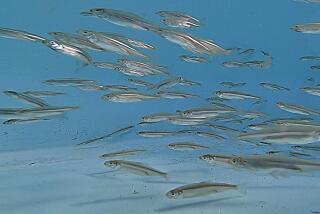Water Exports Seen as Threat to Striped Bass
- Share via
BERKELEY — Striped bass in San Francisco Bay have diminished to such a low level that the species will not survive here unless water shipped to Central and Southern California is cut drastically, environmentalists said Monday.
The environmentalists said this year’s relatively rainy spring should have resulted in greatly increased numbers of striped bass, a popular sport fish in the bay and Sacramento-San Joaquin River Delta.
But as it turned out, there was only a minor increase from 1988, the worst year on record. The count taken by the Department of Fish and Game during the spring spawn was the second lowest since the state started keeping records in 1959.
“For all practical purposes, there was no successful spawn,” said John Beuttler, executive director of United Anglers of California, a sportfishing group. Environmentalists blame the decline on the fact that diversions from the delta cut the fresh water spawning grounds that striped bass require.
Results of the latest so-called striped bass index come as the California Water Resources Board prepares to resume hearings this fall to determine how to divide up the state’s water.
In Monday’s press conference at the Berkeley Marina, environmentalists from such groups as the Natural Resources Defense Council fired prehearing salvos by calling for a 1.5-million-acre-foot reduction of water shipped to Central Valley farmers and Southern California municipalities each year.
Barry Nelson of the Save San Francisco Bay Assn. declared that the species has “collapsed.” He called for a moratorium on additional diversions south and for more conservation by Central Valley farmers, who use upward of 83% of the water.
Water users reacted harshly to the environmentalists’ latest call for a cutback in diversions.
“What makes them think that (reduced diversion) will benefit the fish? There’s not even agreement among the biologists,” said Jason Peltier, manager of the Central Valley Project Water Assn., which represents 80 local water districts that draw on delta water.
David Schuster, a consultant to the state water contractors, including the Metropolitan Water District, termed the charges “a lot of grandstanding.” He agreed that the species is “in big trouble” but said the decline in striped bass is an “indication” of environmental problems in the delta, not the bay.
Environmentalists contend the striped bass is an indicator of the health of the bay and delta. The coalition pointed to declines in salmon runs, shrimp and delta smelt to buttress the contention.
But other experts note that some species, such as sturgeon, are not in decline. Another indication of improved bay water quality is that shellfish such as clams can be picked legally along some sections of the bay’s shore.
Still, state fisheries experts believe that one explanation for the decline in bass is that roughly 6 million acre-feet of fresh water is shipped from the Sacramento-San Joaquin River Delta to Central and Southern California for residential and agricultural use.
These biologists believe the diversion cuts into the population by sucking young bass from the delta, and by reducing the amount of fresh water that flows into and flushes San Francisco Bay.
“There is no question that it (water diversion) is a major thing affecting the environment,” said Donald Stevens, a state Fish and Game supervisor who works on the bass problem.
Exactly what has caused the decline is cause for debate. Besides water diversion, one hypothesis is that there simply are fewer adult striped bass left to spawn than there were 20 years ago. The adult population, once estimated to be 1.6 million, has dropped to 800,000 to 1 million.
A second theory is that the main food of young bass, a crustacean called the eurytemora, is declining for an unknown reason. New species of the crustacean have become more abundant, but they are able to escape hungry young bass.
Still another theory attributes the decline to toxicity. Adult bass are burdened with varying levels of heavy metals and petroleum byproducts.
To supplement the fishery, the state has created hatcheries. A study due out this year will attempt to come up with a long-range plan for the bass.
“I don’t think you can take striped bass and say the whole system has gone to pot,” Stevens said. “But what has happened is an indication of environmental problems in the system.”
More to Read
Sign up for Essential California
The most important California stories and recommendations in your inbox every morning.
You may occasionally receive promotional content from the Los Angeles Times.










